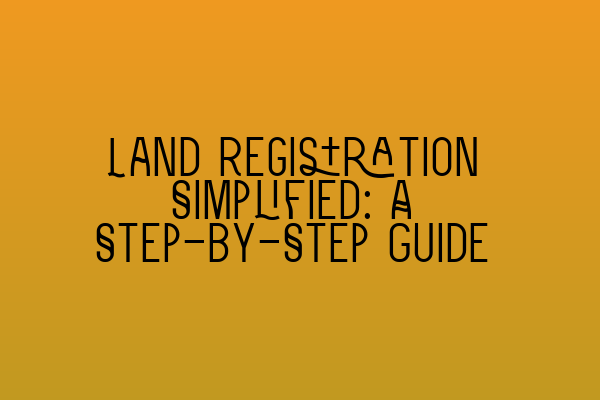Land Registration Simplified: A Step-by-Step Guide
Welcome to the SQE Property Law & Land Law blog! In this article, we will guide you through the process of land registration step by step, making it simple and easy to understand. Whether you are a solicitor looking for a refresher or a law student preparing for the SQE exams, this guide will provide you with valuable insights.
Why is Land Registration Important?
Land registration plays a crucial role in the legal system. It provides certainty and security of ownership, allowing individuals and businesses to have confidence in their property rights. Through the registration process, legal ownership is recorded, and any legal or financial interests in the land are documented and protected.
Now let’s dive into the step-by-step guide:
Step 1: Gather Information
Before starting the land registration process, it is important to gather all the necessary information related to the property. This includes title deeds, contracts, leases, and any other relevant documents.
Need some practice before diving into land registration? Check out our SQE 1 Practice Exam Questions.
Step 2: Complete the Application Form
The next step is to complete the land registration application form. This form is available online or can be obtained from the Land Registry. The application form requires details regarding the property, including its location, boundaries, and any rights or restrictions affecting it.
Want to assess your knowledge before filling out the application form? Take a look at our SQE 1 Practice Mocks FLK1 FLK2.
Step 3: Submit the Application
Once you have completed the application form, you need to submit it to the Land Registry along with the required fee. The Land Registry will review the application and process it accordingly. It is important to ensure that all the information provided is accurate and complete to avoid any delays or rejections.
Step 4: Examination and Verification
After submitting the application, the Land Registry will examine and verify the information provided. This may involve conducting searches, contacting third parties, or requesting additional supporting documents. The process can take several weeks, depending on the complexity of the application and the workload of the Land Registry.
Preparing for your SQE exams? Explore our comprehensive SQE 2 Preparation Courses.
Step 5: Registration and Issuance of Title
Once the Land Registry is satisfied with the application and all necessary requirements are met, they will register the property and issue a title. The title acts as a conclusive evidence of ownership and details any legal interests or restrictions affecting the property.
Step 6: Post-Registration Actions
After the land registration is complete, there may be additional actions required. This could include notifying mortgage lenders, updating insurance policies, or notifying relevant authorities and stakeholders about the change in ownership.
Considering taking the SQE exams? Don’t miss out on our comprehensive SQE 1 Preparation Courses.
Conclusion
Land registration might seem complex, but by following these steps, you can ensure a smooth and successful registration process. Remember to gather all the necessary information, complete the application accurately, and comply with the requirements of the Land Registry. Land registration provides security and certainty for property ownership, making it an essential aspect of property law.
Stay updated with the latest SQE exam dates by visiting our article on SRA SQE Exam Dates.
We hope this step-by-step guide has simplified the land registration process for you. If you have any further questions or need assistance with property law, feel free to contact us at SQE Property Law & Land Law.
